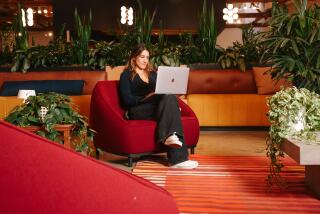Office a Go-Go
- Share via
When the people at Herman Miller talk about the workplace of the future, they don’t use terms like “desk” or “filing cabinet” or “cubicle.”
And they’ve left far behind such onetime status symbols as the monster mahogany roll-top or the Bigelow carpet on the floor. Even the coveted “corner office with the window” is becoming a relic of the Industrial Age.
They prefer “action office panels” or “ethospace frames” or “liaison cabinet systems.” And they talk a lot about fluidity--grabbing a laptop and rolling out a little table for an instant task.
“We’ve become an information-based economy and it’s a whole different paradigm than the traditional office where you sat there all day and pounded out the work,” said Sheryl Smith, southwest director of sales. “It’s happening gradually, but the rate of change is picking up.”
And while most people are aware of this ongoing shift, some are doing more about it than others. Herman Miller, a manufacturer of furniture and furniture systems, puts so much value on research that company reps boast they often uncover needs in the workplace before their customers do.
Designers at their Zeeland, Mich.-based headquarters are armed with data on the anthropometrics of seating, work force diversity, the information economy, technology integration, environmental sustainability and global competition. Although the company is still known for elegant desktops and luxurious ergonomic chairs (comfort and beauty don’t come cheap--the top of the line Aeron executive chairs retail for up to $1,500), Herman Miller is assembling them in a different way.
“Our intention is not just to provide product but to provide capability,” says Barry Mahal of the design and development staff. “The office today is anywhere you need to be.”
Mahal was part of a company team that presented a “FutureVision” evening recently for architects and designers in Los Angeles. Redesigning the office to accommodate changing work patterns is a common preoccupation today, but the Herman Miller party offered a good window on products at a developmental stage. Guests heard keynoter John Picard sketch the high-tech office of the future as a “PC that never closes.”
Herman Miller’s readiness to ease customers into a high-tech future was evident throughout a ballroom of the Beverly Hills Hotel converted into a design showroom, showing off options ranging from mass market to custom choice. The details, frequently described as “solutions,” told volumes.
The company’s Arrio line is free-standing furniture with movable components that can be tailored in a number of ways. The line features height-adjustable table desks with flexible work rails and tackboards. Screens of several heights that let light through can be added or moved to provide different levels of privacy. An optional jackknife surface pivots out from under the desk for quick meetings or overflow work spaces. A stretcher between desk legs provides a large channel to carry cables, keeping them out of sight (no feeding them through little holes), and a power module lets equipment be plugged directly into the desk.
Coupled with the emphasis on function is attention to aesthetics. In one display, fabric swatches floated like sails above tables inlaid with samples of cherry and maple veneer. “We’re introducing 80 new fabrics in six families, plus laminates and veneers to integrate with the woods,” said the firm’s Catherine Bragdon.
While Arrio furniture can stand alone in open plan or enclosed offices, other exhibits took the notion of mobility even further. Because many of Herman Miller’s high-tech clients work in teams, the company has designed a mobile desktop called “Unlimited Boundaries.” It’s on lockable casters, cranks up and down, and can be enlarged with extra desktops and task lighting as the need for teamwork grows and shrinks, said George Morgan, a senior program manager. It can be moved down the hall for a meeting or over to the window for better light. But don’t call it a desk: “We call it an enclosure with a canopy.”
The company also featured the “puzzle cart,” a workstation that can go anywhere and is designed for clients whose workers must travel widely and need an office to go with them--or meet them there. “It has all the key characteristics of an area to work in,” Mahal said.
Even more mobile was the cutting-edge office technology demonstrated by keynoter Picard, who moved his audience beyond today’s commonplace computer, modem, fax and World Wide Web. Picard, the founder of L.A.-based E-Squared Digital, specializes in innovative technology.
“Work is being redefined today,” he said. “Work can be anyplace and anyplace is work.” Picard’s “office” includes a pocket-sized cellular phone, a tiny black laptop with built-in video conferencing capability and a Web TV keyboard that delivers instant access to the Internet.
“The tools of the workplace are getting smaller and smarter,” he said, forecasting the eventual convergence of computer technology and furniture. And though the flexibility of new technology suggests that we may not need offices at all--just a handful of cellular appliances and some access codes--Picard is not predicting the end of an organic work space.
“I love the high-tech stuff, but it makes the physical work environment like your desk even more important,” he said. “You still need the comfort of beautiful furniture--you’ll always need a place to put your kid’s picture.”
More to Read
Inside the business of entertainment
The Wide Shot brings you news, analysis and insights on everything from streaming wars to production — and what it all means for the future.
You may occasionally receive promotional content from the Los Angeles Times.










